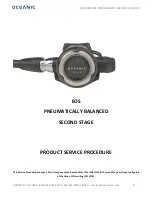
7
Figure 13.
Stud Mounting
For adhesive mount sensors, use a thin, stiff layer of
temporary adhesive such as quick-bonding gel or
superglue. DO NOT use excessive amounts of glue or
epoxy, as the mounting stiffness may be reduced and
compromise high-frequency performance. It may also
damage the sensor during removal.
Figure 14.
Incorrect Adhesive Mounting
Triaxial accelerometers should always be mounted
directly to the reference standard.
Unless absolutely
required, DO NOT use adaptors to re-orient the sensor
along the axis of motion, as the mounting stiffness may
be altered. The vibration at the test sensor sensing
element may differ from the vibration at the reference
standard due to a “cantilever” effect, seen in Figure 15.
Figure 15.
Mounting Triaxial Sensors (Incorrect)
Understand Back-to-Back Calibration limitations.
Do
not expect the uncertainty of calibration to be any better
than
±
2%. (In fact, the uncertainty may be as high as
±
3% or
±
4% for frequencies <10 Hz or >2 kHz.) Since
large sensors may affect high-frequency accuracy, verify
that the test sensor does not mass load the reference
standard. Validate your calibration system with another
accelerometer prior to each calibration session. Check
with the manufacturer for exact system specifications.
7.5 CONCLUSIONS
Without an adequate understanding of dynamics,
determining what, when, and how to test a sensor is a
difficult task. Therefore, each user must weigh the cost,
time, and risk associated with self-calibration versus the
services of an accredited laboratory.
3425 Walden Avenue, Depew, NY 14043
Toll Free: 888-684-0013
•
24-hour SensorLine
SM
: 716-684-0001
•
FAX: 716-685-3886
E-mail: [email protected]
•
Website: www.pcb.com
File name: VIB-CHGOPGUIDE-0702
Doc. No. 18293 Rev. NR































